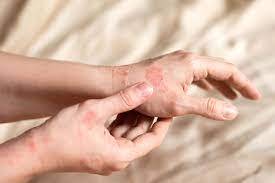Author: Grace Yu (Yu Hsin Tzu)
Traditional Chinese Medicine (TCM) believes that the fundamental cause of eczema lies in the body’s inability to effectively eliminate waste, leading to the accumulation of moisture within. These waste products should be expelled through the urinary system or intestines, but several factors can disrupt this normal detoxification process:
- Imbalance in the Functioning of the Urinary and Excretory Organs: The body’s damp toxins cannot be effectively eliminated through urine and bowel movements.
- Weakness of the Spleen and Stomach: This affects the normal metabolic process, preventing moisture from being effectively expelled.
- Decreased Lung Qi Function: Poor lung function hinders metabolic processes in the skin’s pores, further exacerbating moisture accumulation.
Eczema typically appears on the hands, palms, knees, elbows, and genital areas, causing frequent itching. Scratching can lead to oozing, which may then spread across the body.
Characteristics of Dyshidrosis
Dyshidrosis is a specific type of eczema that mainly occurs on the extremities, such as the palms, sides of the fingers, areas beside the feet, and the spaces between fingers and toes. Due to abnormal moisture metabolism within the body, pores are unable to open and close normally. Additionally, modern lifestyles often involve spending time in air-conditioned environments, which can trap moisture in the skin, leading to the formation of small blisters accompanied by intense itching, redness, and cracking.
TCM Treatment Methods
TCM identifies the main causes of eczema and dyshidrosis as either spleen deficiency with excess dampness or weakness of yin and blood. Treatment plans vary according to individual conditions:
- Damp-Heat Type: Treated with herbs that clear heat and resolve dampness.
- Yin-Blood Deficiency Type: Treated with herbs that nourish, enrich blood, and invigorate circulation.
Additionally, acupuncture is used to balance the body’s constitution and unblock meridians, achieving an internal and external treatment effect that promotes the normal discharge of moisture. The duration of treatment varies based on individual constitution and severity. The first one to two months of treatment primarily focus on detoxifying dampness. As symptoms improve, the underlying constitution will be further adjusted. If the body can effectively balance cold-damp or hot-damp conditions, the likelihood of future eczema flare-ups will be significantly reduced.
Dietary Considerations
Patients with eczema and dyshidrosis should be particularly cautious about their diet. Foods related to cold or raw diets—such as iced beverages, watermelon, mangoes, and seafood (fish and shellfish)—are considered cold in nature and should be avoided to shorten the treatment duration and reduce recurrence until the constitution is adequately adjusted.
Also Read: How To Boost And Improve Your Immune System With Food
Environmental and Lifestyle Recommendations
The living environment should enhance ventilation and reduce humidity. Patients are encouraged to get moderate sunlight exposure daily, which can help alleviate itching caused by moisture. While corticosteroids can temporarily relieve symptoms, long-term use may deplete liver, kidney, and lung qi, diminishing the body’s ability to detoxify and leading to recurrent issues.
Common Acupoints
- Quchi (曲池): Located on the outer side of the elbow crease, this point helps to disperse wind, relieve itching, and unblock meridians.
TCM emphasizes identifying the root cause of the problem and improving the underlying issues with individualized treatment plans.


